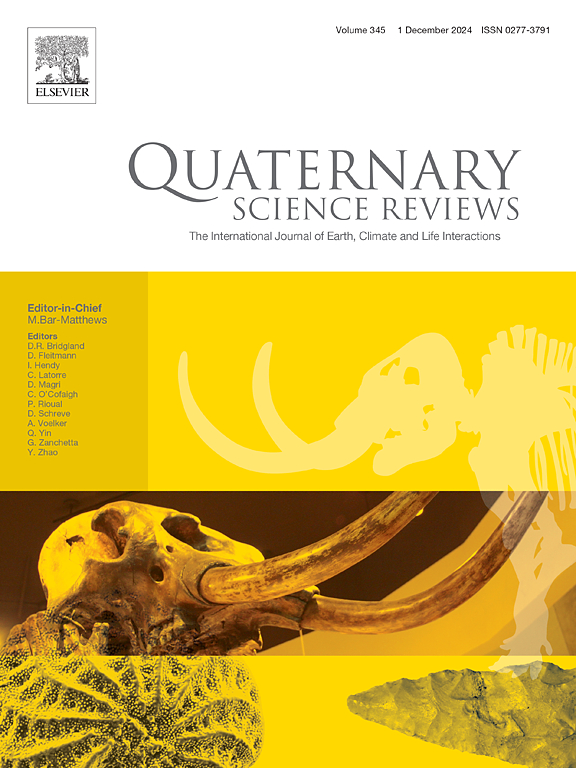2000 years of climate, environmental, and societal variability in southeastern Norway from the annually laminated sediments of Lake Sagtjernet
IF 3.2
1区 地球科学
Q1 GEOGRAPHY, PHYSICAL
引用次数: 0
Abstract
Previous Common Era (i.e., the past 2000 years) climate reconstructions from Fennoscandia have focused on northern and central areas, with scarce data from the southern areas. Using varved sediments from Lake Sagtjernet in southeastern Norway, we developed a hydrogen isotope record from sedimentary leaf waxes (n-alkanes) as a proxy for hydrogen isotopes in precipitation, which we interpret as an indicator of temperature variability over the past 2000 years. The climate reconstruction provides high, decadal resolution for the period 360–770 CE, allowing critical evaluation during the Dark Ages Cold Period (around 300–800 CE) and a cooling during the 6th century, previously suggested as the coldest period of the Common Era. Our results reveal that the most rapid drop in temperature occurred from 536 to 545 CE (+74/-90 years), corresponding in time to the 536 and 540 CE volcanic eruptions. We also document an inferred cold interval that persisted from around 650 to 710 CE (+72/-90 years). While past studies have suggested prolonged cooling during the Dark Ages Cold Period, our findings show that, on average, the climate during 360–770 CE was similar to the Common Era average in the Lake Sagtjernet record. To explore socio-environmental interactions throughout the past 2000 years, we present a pollen-based environmental reconstruction and integrate it with archaeological evidence from around Lake Sagtjernet. These analyses reveal significant societal activities such as land clearing, cereal cultivation, and large-scale iron production, which drastically altered the landscape in the Viking Age (around 800–1050 CE) and the first half of the Norwegian Middle Ages (around 1050–1350 CE). Modern cultivation practices following the Black Death (1349–1350 CE) were first established around 1470 CE and increased continuously until around 1940 CE. Intensification of societal activities through the past millennium, including iron production and modern cultivation, occurred during both warmer (Medieval Climate Anomaly; 950–1250 CE) and colder (Little Ice Age; 1450–1850 CE) periods.

从萨格耶内特湖的年层状沉积物看挪威东南部 2000 年的气候、环境和社会变化
以前来自芬诺斯坎迪亚的共同纪元(即过去2000年)气候重建主要集中在北部和中部地区,南部地区的数据很少。利用挪威东南部Sagtjernet湖的沉积物,我们从沉积叶蜡(正构烷烃)中获得了氢同位素记录,作为降水中氢同位素的代表,我们将其解释为过去2000年温度变化的指标。气候重建为公元360-770年期间提供了高的年代代化分辨率,从而可以对黑暗时代寒冷时期(约公元300-800年)和公元6世纪的降温时期(之前被认为是公元最冷的时期)进行关键评估。结果表明,温度下降最快的时期为536 ~ 545 CE(+74/-90年),与536和540 CE火山喷发时间相对应。我们还记录了一个推断的寒冷间隔,从大约650年持续到710年(+72/-90年)。虽然过去的研究表明,黑暗时代寒冷时期的冷却时间延长,但我们的研究结果表明,平均而言,公元360-770年的气候与Sagtjernet湖记录的普通时代平均值相似。为了探索过去2000年的社会环境相互作用,我们提出了一个基于花粉的环境重建,并将其与Sagtjernet湖周围的考古证据相结合。这些分析揭示了重要的社会活动,如土地清理、谷物种植和大规模的铁生产,这些活动极大地改变了维京时代(约800-1050年)和挪威中世纪上半期(约1050-1350年)的景观。在黑死病(公元1349-1350年)之后,现代种植方法在公元1470年左右首次建立,并不断增加,直到公元1940年左右。在过去一千年中,包括铁生产和现代耕作在内的社会活动的加强发生在两个较暖时期(中世纪气候异常;公元950-1250年)和更冷的时期(小冰期;公元1450-1850年)时期。
本文章由计算机程序翻译,如有差异,请以英文原文为准。
求助全文
约1分钟内获得全文
求助全文
来源期刊

Quaternary Science Reviews
地学-地球科学综合
CiteScore
7.50
自引率
15.00%
发文量
388
审稿时长
3 months
期刊介绍:
Quaternary Science Reviews caters for all aspects of Quaternary science, and includes, for example, geology, geomorphology, geography, archaeology, soil science, palaeobotany, palaeontology, palaeoclimatology and the full range of applicable dating methods. The dividing line between what constitutes the review paper and one which contains new original data is not easy to establish, so QSR also publishes papers with new data especially if these perform a review function. All the Quaternary sciences are changing rapidly and subject to re-evaluation as the pace of discovery quickens; thus the diverse but comprehensive role of Quaternary Science Reviews keeps readers abreast of the wider issues relating to new developments in the field.
 求助内容:
求助内容: 应助结果提醒方式:
应助结果提醒方式:


